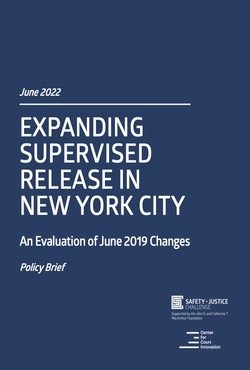Community supervision is a major form of criminal punishment and a major driver of mass incarceration. Over 3.5 million people in the United States are serving terms of probation, parole, or supervised release, and revocations account for nearly half of all prison admissions. Although supervision is intended to prevent crime and promote reentry, it can also interfere with the defendant’s reintegration by imposing onerous restrictions as well as punishment for non-criminal technical violations. Probation officers also carry heavy caseloads, which forces them to spend more time on enforcing conditions and less on providing support.
Fortunately, the criminal justice system also includes a mechanism to solve these problems: early termination of community supervision. From the beginning, the law has always provided a way for the government to cut short a defendant’s term of supervision if they could demonstrate that they had reformed themselves. Recently, judges, correctional officials, and activists have called to increase rates of early termination in order to save resources, ease the reentry process, and encourage rehabilitation. Yet despite all this attention from the field, there are no law-review articles on terminating supervision early.
In this Article, I provide the first comprehensive analysis of early termination of community supervision. First, I recount the long history of early termination, from the invention of probation and parole in the 1800s to the Safer Supervision Act of 2023. Next, I identify and critique recent legal changes that have made it harder for federal criminal defendants to win early termination of supervised release. Finally, I propose the first empirically based sentencing guideline on terminating supervision early, which I recommend in most cases after 18 to 36 months. If community supervision drives mass incarceration, then early termination offers a potential tool for criminal justice reform. American Criminal Law Review, Forthcoming, 2024.
By Michael LaForest
Nearly three-fourths of incarcerated individuals are released under parole supervision in the United States. However, relatively little is known about the effects of supervised release. In this work, I first investigate the effects of early release from prison using the quasi-random assignment of interviewers to parole hearings in Pennsylvania. I find that, at the margin of release, individuals initially paroled experience higher rates of post-release recidivism than individuals released at a later date. Second, I separately identify the effects of the three major components of parole supervision – (1) supervision intensity, (2) special conditions such as curfew or placement in a halfway house, and (3) the assigned parole officer who manages supervision – by leveraging three separate quasi-random assignment mechanisms in Pennsylvania. Along most margins, I find that increased supervision leads to additional parole violations with little effect on future arrests or employment.
Draft Paper, 2022. 41p.
By James Bonta
The search for ‘what works’ in the assessment and rehabilitation of justice-involved persons dates back at least to the 1960s and an argument can be made that it is even earlier than that. However, it was probably Lipton, Martinson, and Wilks’ (1975) review of the treatment literature that catapulted ‘what works’ to the forefront of correctional research and practice. The story of their review and Robert Martinson’s popularisation of the review is well known. The conclusion from the review was that ‘these data…give us little reason to hope that we have in fact found a sure way of reducing recidivism through rehabilitation’ (Martinson, 1974, p.49). This proclamation was quickly translated into ‘nothing works’ and opened the gates to the ‘get tough’ movement. After all, it was argued, if treatment does not work then our only alternative is to punish law-breakers justly and fairly in the hope that it will deter them from further crime. The view that ‘nothing works’ did not go unchallenged. Ted Palmer (1975) was almost alone in supporting rehabilitation efforts at the time. …
Manchester: HM Inspectorate of Probation, 2023. 13p.
By Joanna Weill
New York City jails held an average of 5,468 individuals a day in 2021, 1 far below the peak incarceration of over 20,000 in the early 90s, 2 but above the City’s stated aim of 3,300.3 In working towards this goal, New York City expanded its Supervised Release Program (SRP). Through SRP, individuals awaiting trial are released under community supervision to ensure their return to court, rather than having bail set and/or being detained in jail. The program includes phone and in-person check-ins and connections to voluntary services. More recent iterations of the program have allowed judges to set mandatory programming as a condition of release for participants in SRP. This brief looks at the impact of one SRP expansion implemented in June 2019.
New York: Center for Court Innovation, 2022. 15p.





